Indoor pineapple: care, reproduction and pest control
Pineapple is a perennial herb that belongs to the bromeliad family. The birthplace of this plant is Brazil. how indoor plant it is grown relatively recently.
Content:
- Description of indoor pineapple
- Indoor pineapple care
- Reproduction of indoor pineapple
- Diseases and pests
Description of indoor pineapple
Leaves, beautifully collected in a rosette, give decorative effect to pineapple. Some species bear fruit, but not all grown on the windowsill edible pineapple. The stem is short, rising slightly above the ground surface. Leaves are hard, shaped like a sword, up to 120 cm long, of medium width. They are collected in a dense outlet.
An adult plant can reach a height of 1 meter.
They grow 2 meters wide. The pineapple flower is located on a tall, thick and fleshy peduncle, the height of which can reach 60 cm. The spike-shaped inflorescence has a small rosette of leaves at the end, which remain on the top of the pineapple fruit after ripening. The inflorescence itself consists of many small flowers, painted in a pale purple and greenish-white tone.
Each small bud is covered with a red or greenish bracts. Flowering lasts a month, after which a fruit appears that looks like a bump. It is painted in light brown, green and yellow tones. It is cylindrical in shape, oval and slightly elongated. Experienced gardeners recommend planting pineapple in a wide pot and monitoring the moisture content of the plant's soil. Its flowering begins 2-4 years after planting.
Indoor pineapple care
It is generally believed that growing pineapple at home is difficult. Observing simple rules for care, indoor pineapple will delight you for many years not only with flowering, but also with juicy fruits:
- A well-lit place for growing pineapple must be selected. In nature and in agriculture, this the fruit grown in open fields. South facing windows are great. In good light, the leaves have a rich green color, the rosette is dense, and the young have a reddish tint at the tips. In winter, when the sunny day becomes short, artificial lighting with fluorescent lamps is necessary.
- The ambient temperature in the summer should be between 22-30 degrees, in cold months it should not drop below 18 degrees. So that dry air from artificial heating does not harm the pineapple, it is recommended to place the pot with the plant in a pan with sand, which must be periodically moistened.
- In warm and hot months when the ambient temperature is above 22 degrees to water the plant is necessary abundantly. It is recommended to use soft water at room temperature for this. When the temperature drops to 20 degrees, watering is slightly reduced, and if water gets into the outlet, it must be blotted dry with a napkin. At 15 degrees, it is not recommended to water the plant, as decay may begin and the pineapple will die.
- To feed the flower is needed in the spring and summer season. For this, mineral fertilizers and organic matter are used. They are introduced alternately.
Reproduction of indoor pineapple
Pineapple propagates with the help seed, cuttings, root shoots and children that form at the base of the root rosette after flowering.
Reproduction by seeds:
- Seeds are collected from well-ripened pineapple and washed in a potassium permanganate solution for disinfection. They are small, brownish and slightly curved.
- After drying, they are carefully laid out in a prepared container with soil to a depth of 1 cm.
- Next, you need to pour soft, warm water and make a greenhouse, covering the container with glass or film.
- It is necessary to keep the planted seeds at a temperature of 20 degrees and above. The warmer the air in the room, the faster the seedlings will appear.
Caring for small pineapples is easy, timely spraying and watering... You can also feed the kids with organics. When 2-3 leaves appear, the plant must be taught to the open air, ventilating them daily and increasing the opening time. When the leaves are 7 cm long, the pineapples dive in separate containers with loose soil and good drainage. The pots are placed in a well-lit area with shade from direct sunlight.
Reproduction cuttings:
- For propagation with the help of cuttings, peduncles are used, on which the fruit has not set. A rosette of leaves growing at the top of the fruit is also suitable for these purposes.
- It is cut by about 2 cm along with the top of the pineapple.
- All the pulp is removed, and the rest is dried and treated with a solution of potassium permanganate.
- It is also recommended to treat the cuttings with a strong solution of potassium permanganate, then apply charcoal to the same places.
- Cuttings are dried in a dry, dark place for 2-3 days and planted in a substrate made from turf and wet sand. You can also add charcoal.
- Further, the planted cuttings are covered with foil or glass and transferred to a well-lit place with an air temperature of 23-25 degrees.
- Rooting takes place within 2 months. When the leaves begin to grow, young pineapples can be opened.
- During the entire period, the cuttings are sprayed with soft water at room temperature.
After flowering, babies appear near the root outlet. They develop well if the plant is planted in a sufficiently wide tub. When young shoots reach 20 cm, they can be carefully separated from the mother bush. Very often, young roots are already formed on such processes. However, the cut should be charcoal and allowed to dry in a cool place for 3-5 days.
When the cut is well dried, the separated cuttings are rooted and later planted in a previously prepared substrate.
Rooting such cuttings under a jar or bag in loose soil at a temperature of at least 23 degrees. In this case, the soil in which the plant is located should also warm up a little to 25 degrees. Within a month, the plant takes root. During the entire period, the substrate should be warm and moist so that the young roots do not dry out. It is also recommended to air the plant daily for 5 minutes.
Diseases and pests
A pineapple has recently become a popular houseplant. With improper care, the plant can have problems. Houseplant pests can also attack this plant.
If the leaves of a plant begin to wrinkle or dry out the edges, then this is the first sign that the place and the air are too hot. It is necessary to spray the plant with a spray bottle and move it to a cooler place. If the leaves begin to fade, you need to expose the flower to a brighter place. If rotting appears at the base of the outlet, it is necessary to reduce watering.
Not only illness can harm the pineapple, the scabbard can attack the leaves.
It is removed pointwise, with a cotton swab dipped in ethyl alcohol. If the infection is noticed later, and the scabbard has managed to spread strongly, then the plant and nearby flowers must be treated with an insecticide.Mealy worms, root worms and spider mites can also attack the plant. At the first manifestations of pests, the plant must be treated with proper drug, which you can buy in stores for the hobby gardener.
More information can be found in the video.




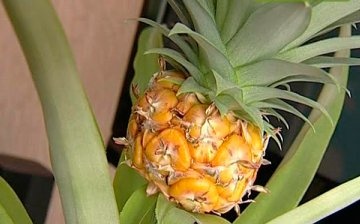
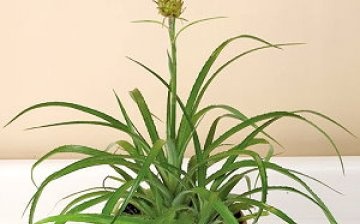
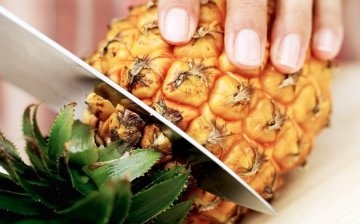
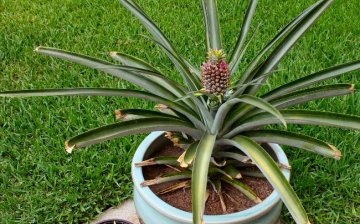





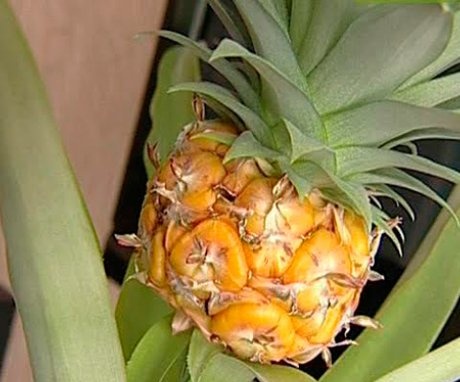
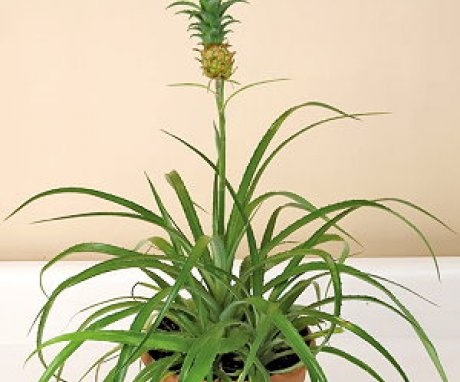
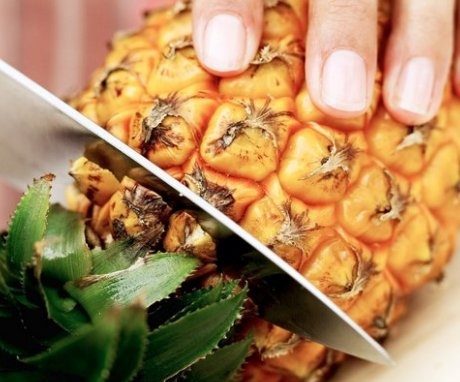
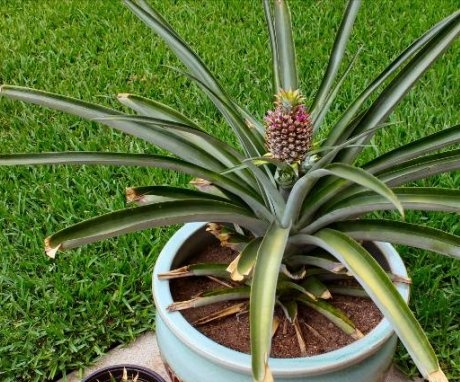
My employee is fond of such exotic things and she managed to grow pineapple from the outlet. Long rooted, raised for two years or more. Then I got tired and decided to try it. Turned out to be edible.